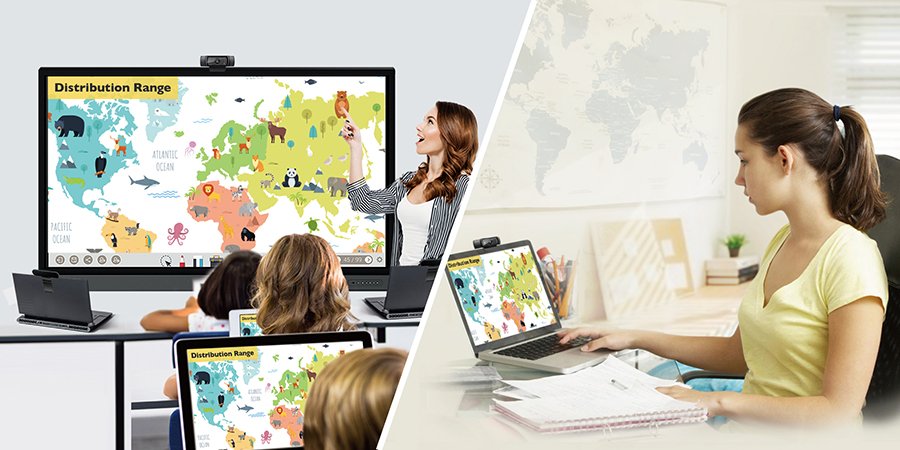Five Problems that Occur While Performing Online Courses
- BenQ
- 2020-04-23
The year 2020 is destined to be unforgettable when taking into account that we are compelled to engage in distance teaching and learning. Some 1.5 billion students, accounting for 87% of student numbers worldwide, are influenced by the 2019-2020 coronavirus pandemic. “Suspending classes without suspending learning” instantly became a new trend in education. Educators all over the world apply themselves to accepting a variety of distance teaching solutions, grasping the opportunity to maintain the spirit of nurturing students and fostering new talent.
We can think of these class suspensions of early 2020 as a kind of test that not only exactly examines the tech capacity schools accumulated over recent years, but also offers a blueprint for schools to carefully ponder future educational technology.
In the long term, the patterns of future education will include more diverse learning scenarios, including in-class lectures, distance teaching, and mixed in-class and distance formats. Through this process, schools are able to create complete educational technology programs, providing teachers and students with high quality teaching and learning in optimal environments.
After checking out teacher and student feedback, we can summarize five problems that occur while performing online courses, it’s likely correlated to “learning efficiency”:
distance learning requires devices online-capable devices along with webcams, microphones, and stable high-speed internet connections. Operating online learning platforms gets difficult if any of these experience technical issues.
in traditional courses, physical books are the norm. It’s sometimes ungainly to directly convert every page into a PowerPoint, especially for text-heavy content with complex concepts.
many teachers are good at preparing experiential teaching aids. In traditional environments, that enables students to learn with all five senses. However, after moving to online courses, teachers and students are limited to visuals and audio, as teaching aids are confined to videos, images, slides, and sounds.
most teachers and students in traditional courses are used to viewing blackboards as visual focuses. Teachers can record class outlines while students can interact by writing on blackboards. The software used in online courses currently includes Zoom, Google Meet, and Panopto, whose advantages lie in good application of sounds and images. However, these apps place little emphasis on online, virtual blackboards that can be easily shared by teachers and students.
it usually takes fifty minutes to complete the average class, but actually the physical and mental attention span of students is approximately fifteen minutes. Lengthy lectures may become a liability, and it’s hard for students to catch up with teachers once distracted during online courses. As a result, most students lose focus within the span of a 50-minute class session.
Here are a few recommended tweaks to help improve distance learning performance:
schools and teachers should select a teaching platform which supports as many various network-connected devices simultaneously as possible. Teachers and students are then able to use their familiar computers, smartphones, and tablets when attending classes. Also, connection procedures should be streamlined and made intuitive.
in traditional courses, good teachers become the focus of class simply by “speaking”. But in online classes, messages and nuances conveyed by body language are limited. So, it’s not easy to maintain student attention for a long time. Teachers should try and learn from YouTubers. Famous YouTubers are good at shortening the distance between them and their remote, online audience. By proposing a question every two to three minutes or allowing students to chat with each other, teachers can warm up class atmosphere.
we suggest to adjust classes to twenty or thirty minutes per lecture, complemented by ten or twenty minutes of group discussion or self-practice. Finally, take twenty-minute breaks to help students rest their eyes.
in every segment of each class, lectures and interactions should be mixed. Freshness is always the best way to capture attention.
in addition to watching, listening, and speaking, teachers can add in finger point movements such as writing, drawing, and jogging. For that, a collaborative online whiteboard is a perfect choice.
As this wave of class suspension hit very fast and wide, most schools adopt free software that allows multi-person video conferences. The first step is to make teachers and students “go online” with just basic video and audio. And yet, an online whiteboard can be a great addition to distance learning, making up for the insufficient interaction offered by basic video conferencing software.
Online whiteboards also include free app versions. Take BenQ EZWrite Live as an example. Teachers and students can upload teaching materials or reports and post notes with a shared online whiteboard. Everyone can mark their notes, jog and sort, similarly to the interactive links of traditional courses. No software installation is required. Webpages can be opened and used on personal laptops or handheld devices.
Moreover, it’s easy to attend classes. Students just need to scan a QR code or enter a class code. A single class can accept as many as 32 students. What’s more, EZWrite Live, developed for diverse education scenarios, assists teachers in controlling classes and reinforcing collaboration between teachers and students.
Teachers can roll call, determine the status of each student’s connection, and gain better ability to manage every class.
In the long term, if online whiteboards integrate with traditional classes, better results will be achieved after the resumption of regular classes. With built-in BenQ interactive displays that include EZWrite, software and hardware integration will conform to more teaching scenarios:
teachers and students perform distance learning at home, synchronously connecting to EZWrite-sharing online whiteboards.

teachers use aids in classrooms (especially large or unmovable experimental items), and operate interactive flat panels that run EZWrite at the same time. Students stay at home and use EZWrite Cloud Whiteboard remotely to connect to an online whiteboard so as to collaborate synchronously with teachers in classrooms.

The wave of class suspension will eventually come to an end. After this test, the educational technology proficiency of schools and teachers will obviously increase because of it. Although we often say educational technology isn’t the essence of education, classroom learning efficiency still depends on lecture contents and student motivation. However, building high quality learning patterns and devices able to adapt to various scenarios has always been the goal of education technology, and always at the core of planning future products and solutions.